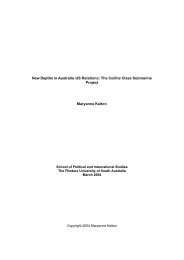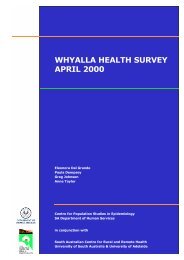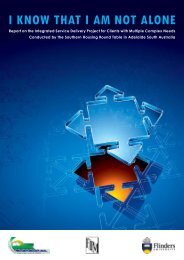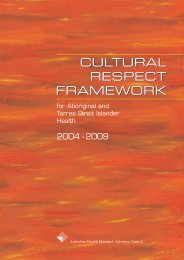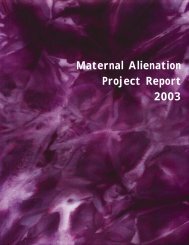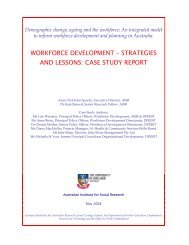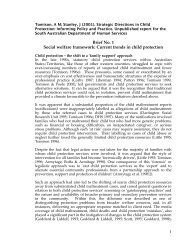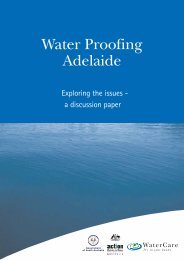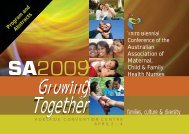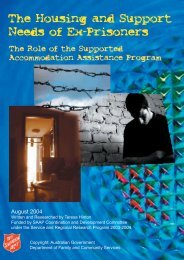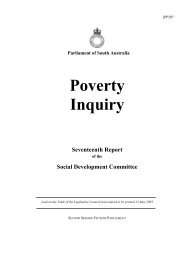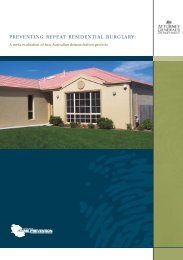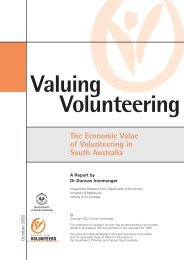Brief No. 2 Social welfare framework - Australian Institute of Family ...
Brief No. 2 Social welfare framework - Australian Institute of Family ...
Brief No. 2 Social welfare framework - Australian Institute of Family ...
You also want an ePaper? Increase the reach of your titles
YUMPU automatically turns print PDFs into web optimized ePapers that Google loves.
Webb et al. (1995)<br />
Keeping Families Together is an intensive family preservation program which<br />
works with families in which children are at imminent risk <strong>of</strong> placement in<br />
substitute care because <strong>of</strong> abuse, neglect or conflict. The model <strong>of</strong> service delivery<br />
is based on a model developed in Maryland USA in which social workers and<br />
family workers work in pairs. The paper explains why Anglican Community<br />
Services chose the model, and how the model has evolved over time. Experiences<br />
<strong>of</strong> working with families are related which illustrate aspects <strong>of</strong> how the program<br />
works. The authors explore the possibility that differences between models <strong>of</strong><br />
intensive family preservation, agency contexts and social settings may create<br />
different outcomes for clients and for workers. Two sets <strong>of</strong> differences are focused<br />
on: the combination <strong>of</strong> a behavioural approach with a family systems based<br />
therapeutic approach; and the use <strong>of</strong> workers in pairs.<br />
Permanency<br />
Bath (2000)<br />
This paper from the symposium on permanency planning held at the 7th National<br />
<strong>Australian</strong> <strong>Institute</strong> <strong>of</strong> <strong>Family</strong> Studies Conference focuses on the tension involved<br />
in any decision making process in child <strong>welfare</strong> where competing rights and<br />
realities need to be juggled. The concept <strong>of</strong> permanence with regard to child<br />
<strong>welfare</strong> is one <strong>of</strong> many principles that influence contemporary practice; others<br />
include normalisation, localisation, deinstitutionalisation, least restrictive or<br />
detrimental alternative, and family preservation. The competing principles are<br />
laudable in their own right when applied thoughtfully, suggests the author, but<br />
they may actually be inimical to the achievement <strong>of</strong> permanence. He reviews some<br />
<strong>of</strong> the legal and ethical impediments to promoting permanence; discusses some<br />
social and ‘market’ realities influencing out-<strong>of</strong>-home care practice; and reviews<br />
some <strong>of</strong> the relevant data and the implications <strong>of</strong> policy shift for indigenous<br />
children. Developmental realities include the role <strong>of</strong> identity issues in placement<br />
breakdown and the practice complications introduced by the arbitrary termination<br />
<strong>of</strong> parental rights where best practice suggests ‘open adoption’ and inclusive foster<br />
parenting. Ultimately, concludes the author, the right to permanence needs to be<br />
balanced against competing rights to a secure identity and open access.<br />
O’Neill (2000)<br />
A symposium on permanency planning was held at the seventh national<br />
conference <strong>of</strong> the <strong>Australian</strong> <strong>Institute</strong> <strong>of</strong> <strong>Family</strong> Studies in Sydney in July 2000.<br />
This paper from the symposium covers the following themes which are related to<br />
termination <strong>of</strong> parental rights and the movement <strong>of</strong> children from one family to<br />
another on the grounds <strong>of</strong> protecting them from abuse or neglect: whether birth<br />
parents are supported sufficiently to keep their children; how and when decisions<br />
should be made to remove children from their birth families; and the relationship<br />
between birth and permanent families. Overseas and <strong>Australian</strong> research,<br />
legislation and practice are examined, and the question <strong>of</strong> whether termination <strong>of</strong><br />
parental rights is appropriate within the current <strong>Australian</strong> context is then looked<br />
at in the light <strong>of</strong> this literature.<br />
34



